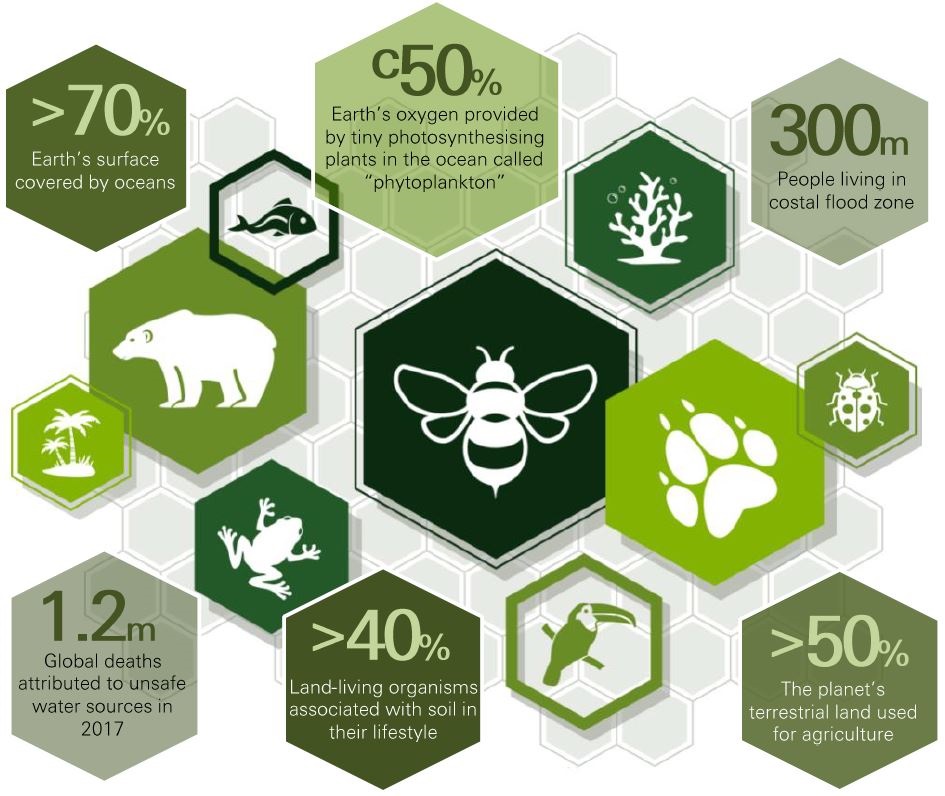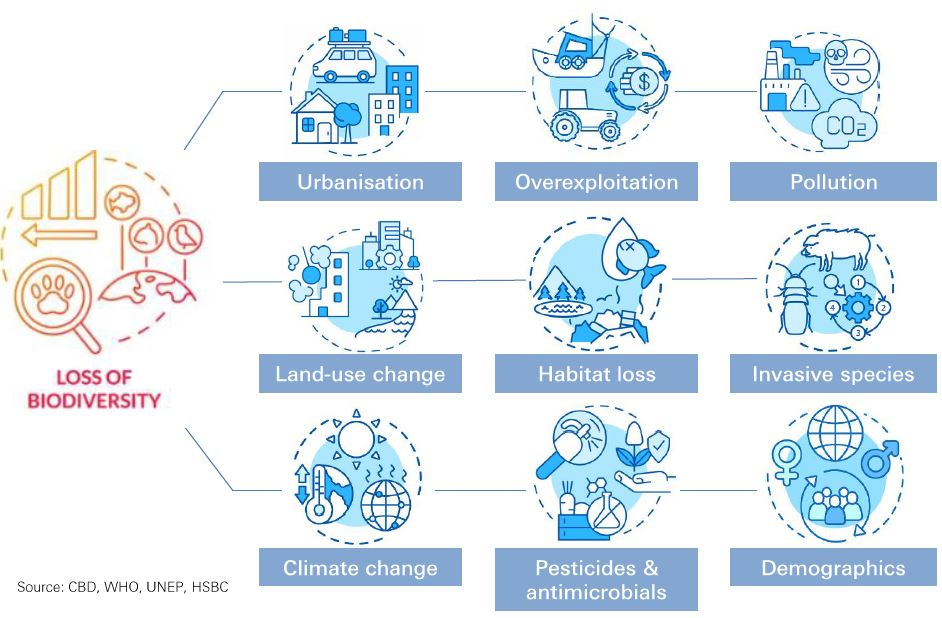Biodiversity and Health

7 Jun 2023
The decline in biodiversity is having an ever-greater impact on human health and well-being services, with linkages to disaster risks, diseases, nutrition, medicine, air and water quality being increasingly recognised.
In this edition, we explore how decreasing levels of biodiversity are negatively affecting human health outcomes and examine the support provided by the Convention on Biological Diversity and its various Parties in restoring balance.
Biodiversity is all the different kinds of life you’ll find in one area and how they interact with the ecosystem - the variety of animals, plants, fungi, and even microorganisms like bacteria that make up our natural world. Each of these species and organisms work together within ecosystems, like an intricate web, to maintain balance and support life. Biodiversity is essential for providing us with resources we need to survive, such as food, clean water, medicine and shelter1.

The crucial role of biodiversity in supporting ecosystems and delivering ecosystem services is closely connected to human health. Biodiverse ecosystems provide essential services such as food, clean air, medicine, natural disaster risk reduction and spiritual values, which fundamentally influence the mental and physical health of human populations.
This is increasingly being recognised globally by intergovernmental and subnational parties. The World Health Organization’s (WHO) One Health approach (see below) has been supported by many parties such as the Food and Agriculture Organization (FAO), the United Nations (UN), the World Bank and the Convention on Biological Diversity (CBD).
The One Health approach aims to achieve optimal health outcomes for ecosystems, people and all living beings by recognising the fundamental linkages between them. It brings together expertise from multiple sectors, strengthening collaboration and data sharing, to address the common drivers of biodiversity loss (Chart 1) and integrate approaches to prevent and detect health risks. Key components of this transition include: conserving and restoring ecosystems, and promoting safe (and legal) use of wildlife, sustainable agriculture, healthy cities and sustainable consumption2 .
Despite the fundamental role that biodiversity plays in health, its levels continue to decline due to various human activities (Chart 1), which inhibit essential ecosystem services and often lead to negative outcomes for health and well-being. In 2015, the CBD and WHO collaborated on a review of the linkages between biodiversity and health, the risks that biodiversity loss poses to health, and ways forward 3. We dive into these in the following section.

Biodiversity loss poses a risk to the health and well-being of our society across multiple areas which we discuss below.

Biodiversity underpins water systems via regulating nutrient cycles, soil erosion, pollution and water purification. However, while clean water is essential for human health, it’s often polluted by water-intensive industries, such as agriculture, textiles and construction as well as mining activities, which put freshwater and mountain ecosystems at risk. Roughly 2.2bn people don’t have access to safely managed drinking water and sanitation services4 and it’s estimated that unsafe water sources were responsible for 1.2m deaths in 20175, with the most pronounced impacts on women, children and less developed regions.

Clean air is vital for healthy outcomes, yet air pollution was responsible for approximately 7m deaths in 2012, with asthma and chronic pulmonary diseases becoming more prevalent. Biodiverse ecosystems can play a direct role in removing air pollution and altering meteorological patterns to improve air quality.

The agriculture and food sectors play a fundamental part in providing healthy diets and nutrients. However, farming relies on biodiversity to provide services like nutrient cycling, water regulation, pollination and pest control, which are necessary to support above-ground crops. Agricultural productivity has increased significantly over the last 50 years and approximately 50% of the planet’s terrestrial land is now used for agriculture6, but food insecurity and undernourishment remain prevalent globally. Modern agriculture methods rely on synthetic fertilisers, which can destroy ecosystems and increase the vulnerability of these production systems to yield reliable and nutritious food sources for human health7.

Many of today’s infections and diseases are largely treatable with medicine that owes its existence to biodiversity. The discovery of natural products, particularly antibiotics, has contributed significantly to breakthroughs in healthcare. However, with many species threatened by extinction, we risk losing potential pharmacologic resources, which could have long-term impacts to human health.

At the microbial level, humans rely on the diversity within their bodies to regulate bodily systems. The depletion of microbial diversity in the human microbiome, which can result from reduced contact between people and the natural environment, has been linked to a range of non-communicable diseases across the globe, including allergic disorder, asthma and Crohn’s disease.
Pathogen and infectious diseases can likewise be linked to biodiversity. The encroachment of human activities and the destruction of ecosystems can increase the risk of emergence and spread of zoonotic diseases (infections transmitted from animals to humans)8. The COVID-19 pandemic has highlighted the pressure placed on habitats and the risk of disease outbreaks. It has also drawn attention to the need to address inequities in global health, including access to medicines.

Biodiversity is an integral part of many cultures and traditions, and exposure to natural environments ultimately enhances mental and physical well-being. However, with urbanisation on the rise and an increasing number of people living in these urban areas, we’re depriving ourselves of the physiological and psychological benefits that nature provides.

The impact of climate change on human health is expected to intensify due to damaged food production, the spread of diseases, reduced air quality, heat stress and natural disasters. Sustainable consumption and production are essential because of demographic changes and their impact on biodiversity and the environment as a whole. Behavioural change is key to the transition, which seeks to protect biodiversity, human health and their complex linkages. Nonetheless, biodiversity can also help to restore ecosystems with the resources necessary to reduce greenhouse gases emissions and build resilience to climate disasters.
As biodiversity is integral to sectors that influence health outcomes, such as pharmacy, biochemistry, biotechnology, tourism and agriculture, its health benefits can help to achieve the Sustainable Development Goals (SDGs), particularly Goal 3, which is to promote “Good health and well-being”. Strategies like nature-based solutions, which encompass urban green spaces and regenerative agriculture practices, can help to find harmony between people and nature.
The Convention on Biological Diversity (CBD) has worked to raise awareness of the interlinkages between health and biodiversity in its efforts to safeguard biodiversity. At the 10th Conference of the Parties (COP10) in October 2010, the Strategic Plan for Biodiversity (2011-2020) was adopted, which included 20 Aichi Biodiversity Targets. These targets aim to address the ongoing decline in biodiversity and to promote the sustainable use of natural resources.
Aichi Target 14 explicitly focuses on ecosystem services that contribute to health, livelihoods and well-being, and the CBD also states that all the Targets have potential linkages to health and well-being. This support for biodiversity and health outcomes was further emphasised at COP12 (2014) and COP13 (2016), where increased collaboration was called upon between the CBD, WHO and other organisations to strengthen the implementation of the plan.
As the global health crisis of COVID-19 swept across the world, a draft Global Action Plan for Biodiversity and Health was devised. This plan aims to support Parties in implementing a biodiversity-inclusive One Health approach and to encourage Parties to incorporate biodiversity and health linkages into national policies.
More recently, during COP15 in Montreal last year, a new Kunming-Montreal Global Biodiversity Framework (GBF) to 2030 was adopted. This frameworks covers conservation, sustainable use, access and benefits sharing, as well as the five main drivers of biodiversity loss - changes in land and sea use, exploitation of organisms, climate change, pollution, and invasive alien species.
The health of humans and the health of the planet are intertwined. And healthy ecosystems require a diversity of biological interactions to deliver ecosystems services. To make progress towards the One Health approach, social and economic development therefore needs to support both humans and nature. Investors should be aware of the increasing focus on biodiversity when it comes to health and well-being so they can position for the opportunities that may arise within the theme.
Related Insights

As expected, the FOMC chose to skip a rate hike at the June meeting, leaving the Fed funds rate in a range of 5.0% to 5.25%.

Consumption, particularly services, continues to fuel China’s economic recovery

Slowing exports and global financial jitters stiffen headwinds to growth…

Disclaimer
This document has been issued by HSBC Bank (Taiwan) Limited (“the Bank”) in the conduct of its regulated business in Taiwan and may be distributed in other jurisdictions where its distribution is lawful. The content is for your reference only. The contents of this document may not be reproduced or further distributed to any person or entity, whether in whole or in part, for any purpose. This document must not be distributed to any other jurisdiction where its distribution is unlawful. All non-authorised reproduction or use of this document will be the responsibility of the user and may lead to legal proceedings.
This document has no contractual value and is not and should not be construed as an offer or the solicitation of an offer or a recommendation for the purchase or sale of any investment in any jurisdiction in which such an offer is not lawful or subscribe for, or to participate in, any services. The Bank is not recommending or soliciting any action based on it.
The information stated and/or opinion(s) expressed in this document are provided by HSBC Global Asset Management Limited. We do not undertake any obligation to issue any further publications to you or update the contents of this document and such contents are subject to changes at any time without notice. They are expressed solely as general market information and/or commentary for general information purposes only and do not constitute investment advice or recommendation to buy or sell investments or guarantee of returns. The Bank has not been involved in the preparation of such information and opinion. The Bank makes no guarantee, representation or warranty and accepts no responsibility for the accuracy and/or completeness of the information and/or opinions contained in this document, including any third party information obtained from sources it believes to be reliable but which has not been independently verified. In no event will the Bank or HSBC Group be liable for any damages, losses or liabilities including without limitation, direct or indirect, special, incidental, consequential damages, losses or liabilities, in connection with your use of this document or your reliance on or use or inability to use the information contained in this document.
In case you have individual portfolios managed by HSBC Global Asset Management Limited, the views expressed in this document may not necessarily indicate current portfolios' composition. Individual portfolios managed by HSBC Global Asset Management Limited primarily reflect individual clients' objectives, risk preferences, time horizon, and market liquidity.
The Bank and HSBC Group and/or their officers, directors and employees may have positions in any securities or financial instruments mentioned in this document (or in any related investments) (if any) and may from time to time add to or dispose of any such securities or financial instruments or investments. The Bank and its affiliates may act as market maker or have assumed an underwriting commitment in the securities or financial instruments discussed in this document (or in related investments) (if any), may sell them to or buy them from customers on a principal basis and may also perform or seek to perform investment banking or underwriting services for or relating to those companies.
The information contained within this document has not been reviewed in the light of your personal circumstances. Please note that this information is neither intended to aid in decision making for legal, financial or other consulting questions, nor should it be the basis of any investment or other decisions. You should carefully consider whether any investment views and investment products are appropriate in view of your investment experience, objectives, financial resources and relevant circumstances. The investment decision is yours but you should not invest in any product unless the intermediary who sells it to you has explained to you that the product is suitable for you having regard to your financial situation, investment experience and investment objectives. The relevant product offering documents should be read for further details.
Some of the statements contained in this document may be considered forward-looking statements which provide current expectations or forecasts of future events. Such forward looking statements are not guarantees of future performance or events and involve risks and uncertainties. Such statements do not represent any one investment and are used for illustration purpose only. Customers are reminded that there can be no assurance that economic conditions described herein will remain in the future. Actual results may differ materially from those described in such forward-looking statements as a result of various factors. We can give no assurance that those expectations reflected in those forward-looking statements will prove to have been correct or come to fruition, and you are cautioned not to place undue reliance on such statements. We do not undertake any obligation to update the forward-looking statements contained herein, whether as a result of new information, future events or otherwise, or to update the reasons why actual results could differ from those projected in the forward-looking statements.
Investment involves risk. It is important to note that the capital value of investments and the income from them may go down as well as up and may become valueless and investors may not get back the amount originally invested. Past performance contained in this document is not a reliable indicator of future performance whilst any forecasts, projections and simulations contained herein should not be relied upon as an indication of future results. Past performance information may be out of date. For up-to-date information, please contact your Relationship Manager.
Investment in any market may be extremely volatile and subject to sudden fluctuations of varying magnitude due to a wide range of direct and indirect influences. Such characteristics can lead to considerable losses being incurred by those exposed to such markets. If an investment is withdrawn or terminated early, it may not return the full amount invested. In addition to the normal risks associated with investing, international investments may involve risk of capital loss from unfavourable fluctuations in currency values, from differences in generally accepted accounting principles or from economic or political instability in certain jurisdictions. Narrowly focused investments and smaller companies typically exhibit higher volatility. There is no guarantee of positive trading performance. Investments in emerging markets are by their nature higher risk and potentially more volatile than those inherent in some established markets. Economies in emerging markets generally are heavily dependent upon international trade and, accordingly, have been and may continue to be affected adversely by trade barriers, exchange controls, managed adjustments in relative currency values and other protectionist measures imposed or negotiated by the countries with which they trade. These economies also have been and may continue to be affected adversely by economic conditions in the countries in which they trade. Mutual fund investments are subject to market risks. You should read all scheme related documents carefully. The relevant investment risks of mutual fund investments are disclosed in fund prospectuses for your perusal. The past performance of fund manager should not be construed as the guarantee of any fund’s minimum return or similar performance in the future. Prospective investors shall seek independent opinions on individual investment programs for their particular interests and needs or on relevant factors. Investors shall make their own judgment in investments, and shall assume full responsibility on any gain/loss, or any direct or indirect loss deriving from the information provided.
The Bank shall fulfill the fiduciary duty act as a reasonable person once in exercising offering/ conducting ordinary care in offering trust services/ business.
However, the Bank disclaims any guaranty on the management or operation performance of the trust business.
Notes
1. World Wildlife Fund
2. 'Global Biodiversity Outlook 5’, UN, CBD, 2020
3. 'Connecting Global Priorities: Biodiversity and Human Health: A State of Knowledge Review’, CBD, WHO, UNEP, 2015
4. UNICEF
5. ‘Clean water’, Our World in Data, 2019
6. FAO, ITPS, GSBI, SCBD and EC. 2020. State of knowledge of soil biodiversity - Status, challenges and potentialities
7. 'Connecting Global Priorities: Biodiversity and Human Health: A State of Knowledge Review’, CBD, WHO, UNEP, 2015
8. Global Biodiversity Outlook 5 2011-2020, UN Environmental Program, Conventions on Biological diversity